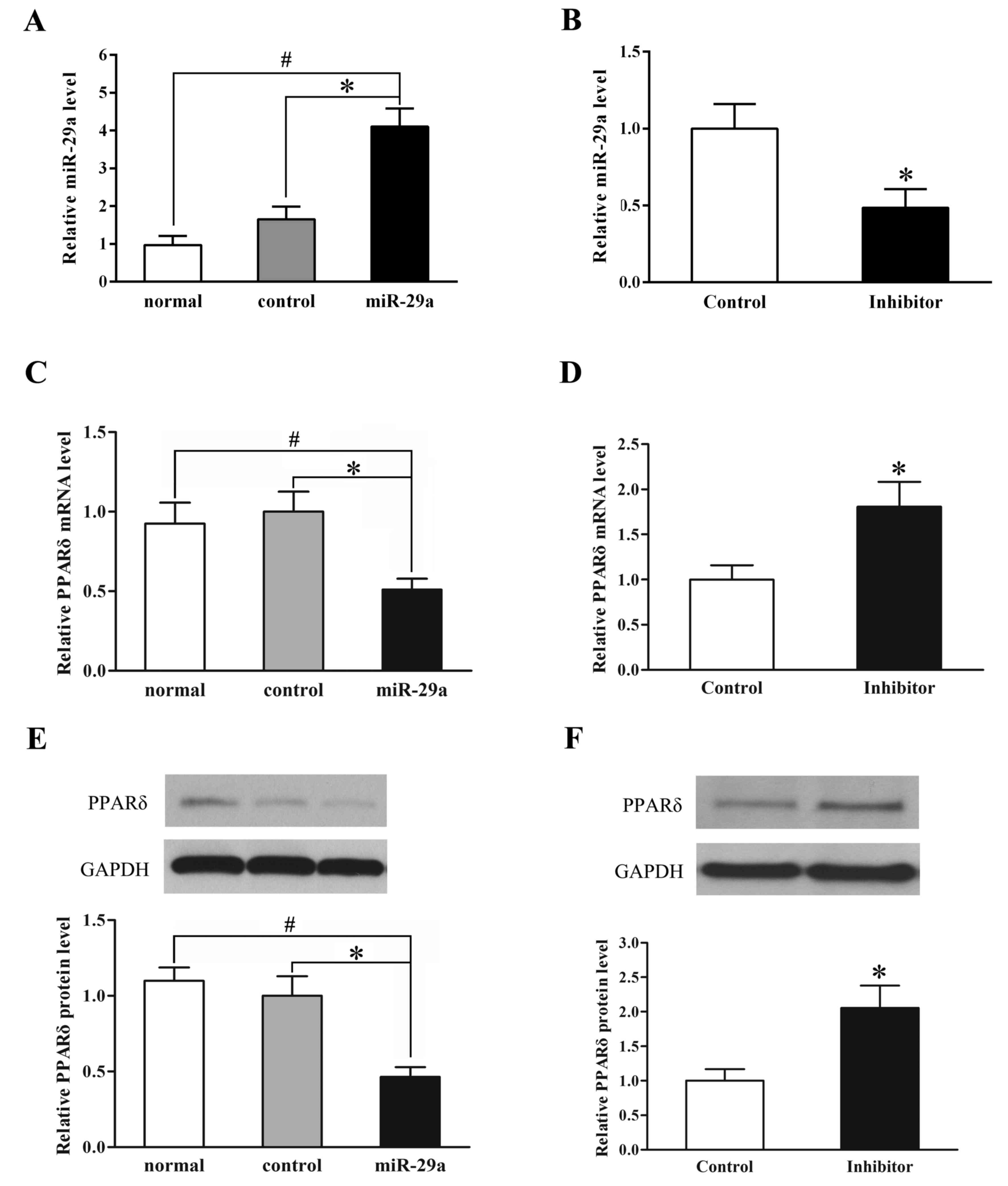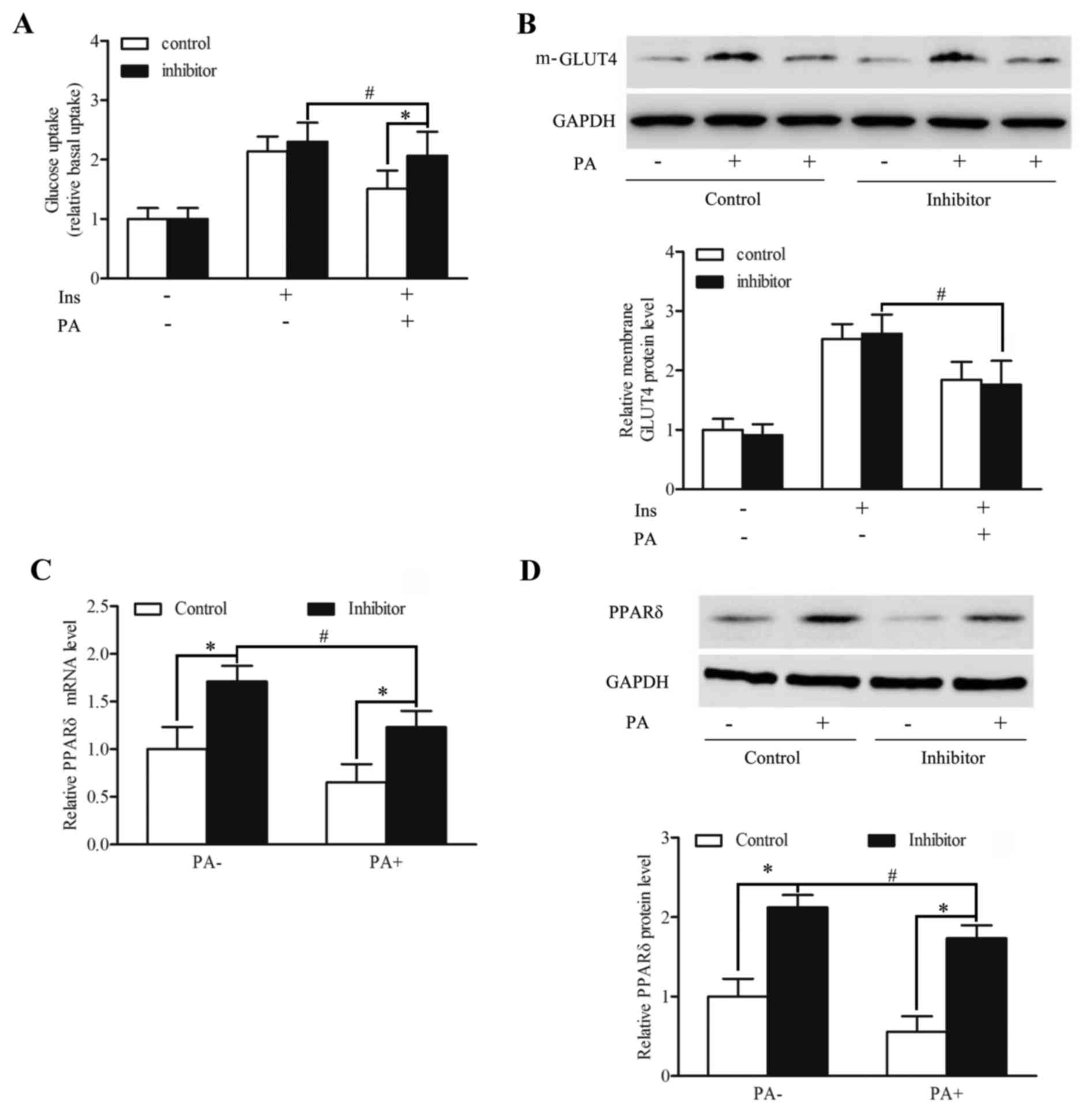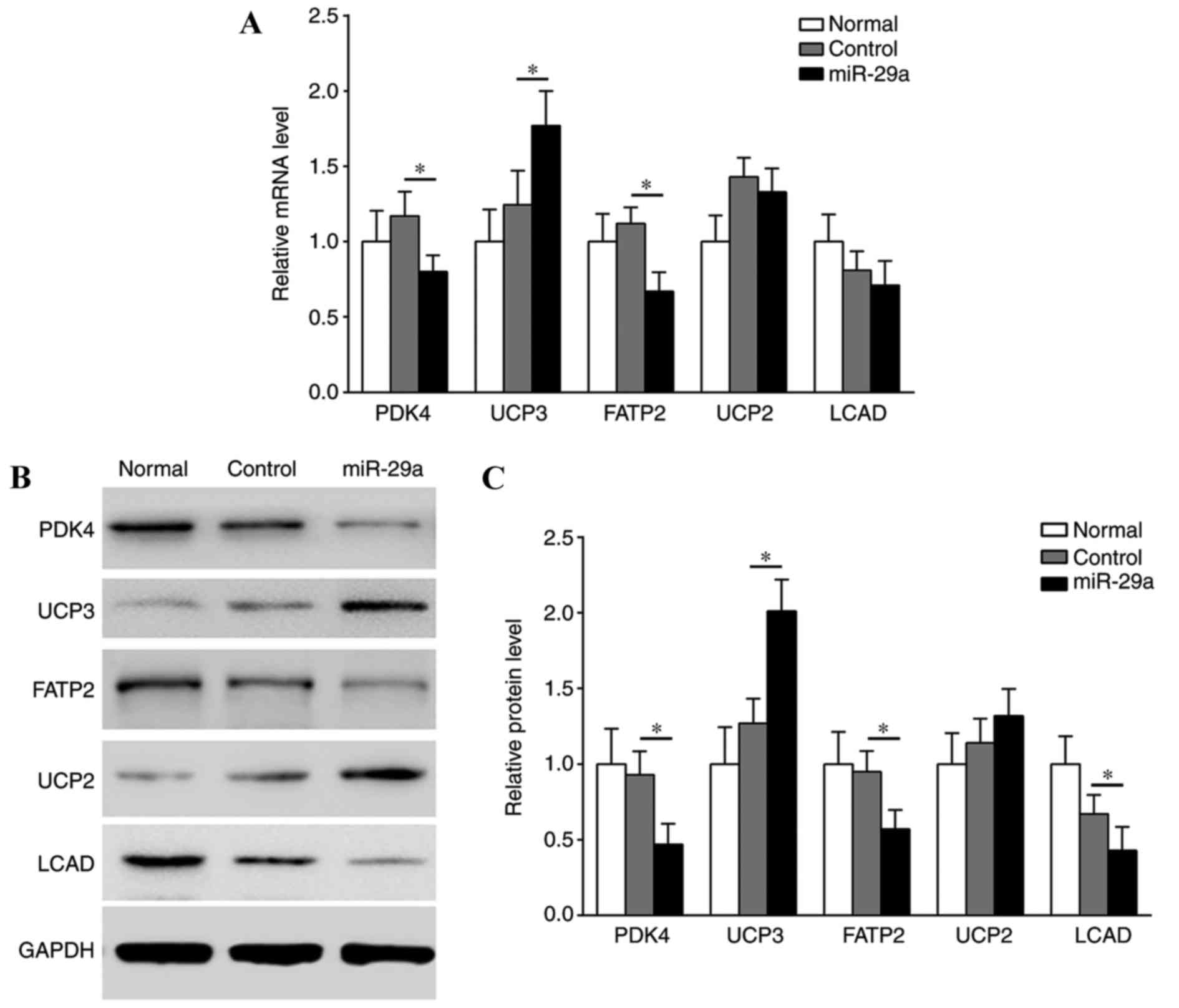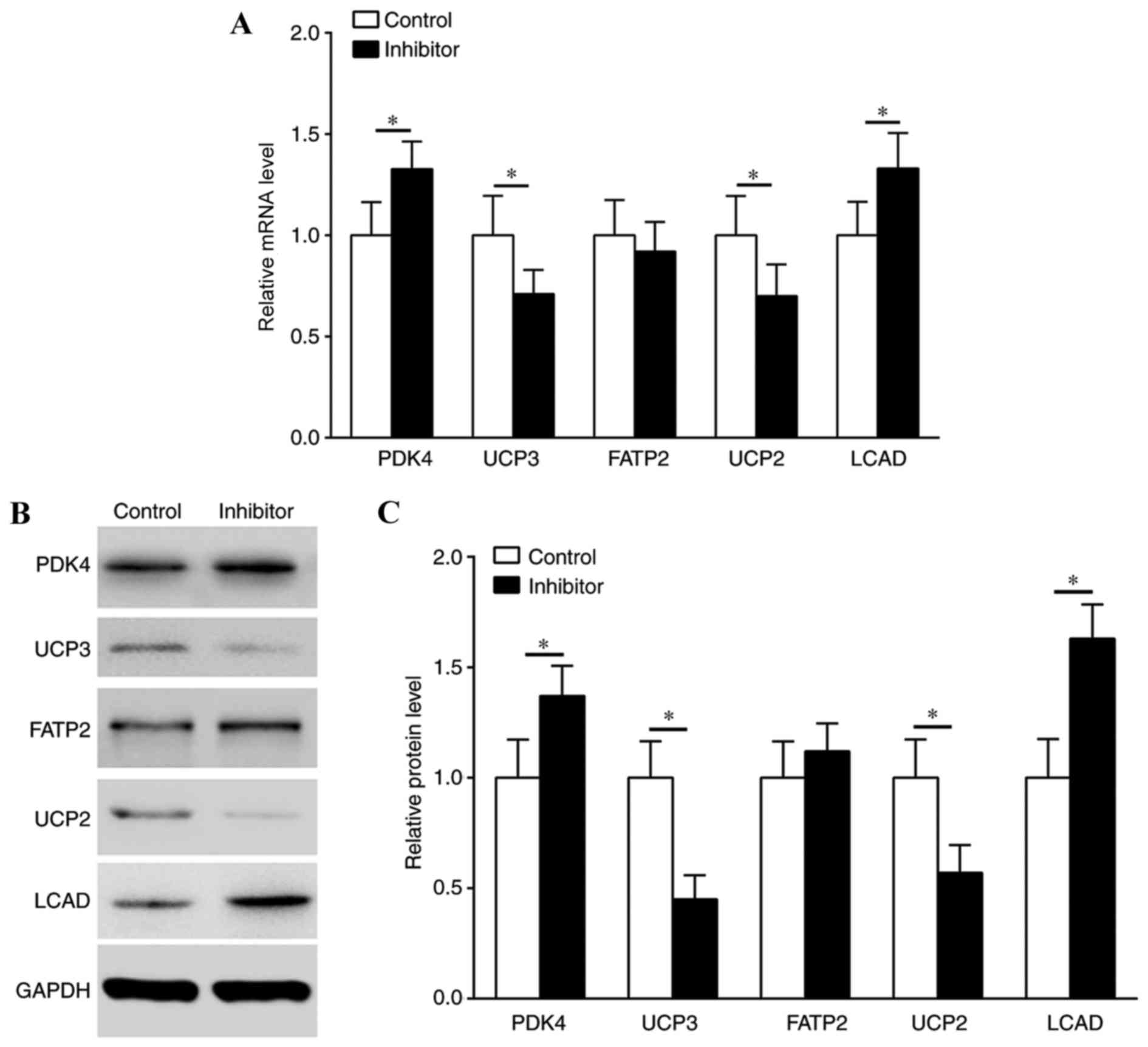|
1
|
Phillips DI, Barker DJ, Hales CN, Hirst S
and Osmond C: Thinness at birth and insulin resistance in adult
life. Diabetologia. 37:150–154. 1994. View Article : Google Scholar : PubMed/NCBI
|
|
2
|
Bouzakri K, Koistinen HA and Zierath JR:
Molecular mechanisms of skeletal muscle insulin resistance in type
2 diabetes. Curr Diabet Rev. 1:167–174. 2005. View Article : Google Scholar
|
|
3
|
Goodpaster BH and Wolf D: Skeletal muscle
lipid accumulation in obesity, insulin resistance, and type 2
diabetes. Pediatr Diabetes. 5:219–226. 2004. View Article : Google Scholar : PubMed/NCBI
|
|
4
|
Morino K, Petersen KF and Shulman GI:
Molecular mechanisms of insulin resistance in humans and their
potential links with mitochondrial dysfunction. Diabetes. 55 Suppl
2:S9–S15. 2006. View Article : Google Scholar : PubMed/NCBI
|
|
5
|
Di Meo S, Iossa S and Venditti P: Skeletal
muscle insulin resistance: Role of mitochondria and other ROS
sources. J Endocrinol. 233:R15–R42. 2017. View Article : Google Scholar : PubMed/NCBI
|
|
6
|
Morales PE, Bucarey JL and Espinosa A:
Muscle lipid metabolism: Role of lipid droplets and perilipins. J
Diabetes Res. 2017:17893952017. View Article : Google Scholar : PubMed/NCBI
|
|
7
|
Ambros V: The functions of animal
microRNAs. Nature. 431:350–355. 2004. View Article : Google Scholar : PubMed/NCBI
|
|
8
|
Bartel DP: MicroRNAs: Genomics,
biogenesis, mechanism, and function. Cell. 116:281–297. 2004.
View Article : Google Scholar : PubMed/NCBI
|
|
9
|
Quinn JJ and Chang HY: Unique features of
long non-coding RNA biogenesis and function. Nat Rev Genet.
17:47–62. 2016. View Article : Google Scholar : PubMed/NCBI
|
|
10
|
McClelland AD and Kantharidis P: microRNA
in the development of diabetic complications. Clin Sci (Lond).
126:95–110. 2014. View Article : Google Scholar : PubMed/NCBI
|
|
11
|
Zhou T, Meng X, Che H, Shen N, Xiao D,
Song X, Liang M, Fu X, Ju J, Li Y, et al: Regulation of insulin
resistance by multiple MiRNAs via targeting the GLUT4 signalling
pathway. Cell Physiol Biochem. 38:2063–2078. 2016. View Article : Google Scholar : PubMed/NCBI
|
|
12
|
Fde Frias T, de Mendonça M, Martins AR,
Gindro AF, Cogliati B, Curi R and Rodrigues AC: MyomiRs as markers
of insulin resistance and decreased myogenesis in skeletal muscle
of diet-induced obese mice. Front Endocrinol (Lausanne).
7:762016.PubMed/NCBI
|
|
13
|
He A, Zhu L, Gupta N, Chang Y and Fang F:
Overexpression of micro ribonucleic acid 29, highly up-regulated in
diabetic rats, leads to insulin resistance in 3T3-L1 adipocytes.
Mol Endocrinol. 21:2785–2794. 2007. View Article : Google Scholar : PubMed/NCBI
|
|
14
|
Zhou Y, Gu P, Shi W, Li J, Hao Q, Cao X,
Lu Q and Zeng Y: MicroRNA-29a induces insulin resistance by
targeting PPARδ in skeletal muscle cells. Int J Mol Med.
37:931–938. 2016. View Article : Google Scholar : PubMed/NCBI
|
|
15
|
Kong L, Zhu J, Han W, Jiang X, Xu M, Zhao
Y, Dong Q, Pang Z, Guan Q, Gao L, et al: Significance of serum
microRNAs in pre-diabetes and newly diagnosed type 2 diabetes: A
clinical study. Acta Diabetol. 48:61–69. 2011. View Article : Google Scholar : PubMed/NCBI
|
|
16
|
Peng H, Zhong M, Zhao W, Wang C, Zhang J,
Liu X, Li Y, Paudel SD, Wang Q and Lou T: Urinary miR-29 correlates
with albuminuria and carotid intima-media thickness in type 2
diabetes patients. PloS One. 8:e826072013. View Article : Google Scholar : PubMed/NCBI
|
|
17
|
Tao W, Dong X, Kong G, Fang P, Huang X and
Bo P: Elevated circulating hsa-miR-106b, hsa-miR-26a, and
hsa-miR-29b in type 2 diabetes mellitus with diarrhea-predominant
irritable bowel syndrome. Gastroenterol Res Pract.
2016:92562092016. View Article : Google Scholar : PubMed/NCBI
|
|
18
|
Doktorova M, Zwarts I, Zutphen TV, Dijk
TH, Bloks VW, Harkema L, Bruin A, Downes M, Evans RM, Verkade HJ
and Jonker JW: Intestinal PPARδ protects against diet-induced
obesity, insulin resistance and dyslipidemia. Sci Rep. 7:8462017.
View Article : Google Scholar : PubMed/NCBI
|
|
19
|
Sprecher DL: Lipids, lipoproteins, and
peroxisome proliferator activated receptor-delta. Am J Cardiol.
100:n20–n24. 2007. View Article : Google Scholar : PubMed/NCBI
|
|
20
|
Cox RL: Rationally designed PPARδ-specific
agonists and their therapeutic potential for metabolic syndrome.
Proc Natl Acad Sci USA. 114:3284–3285. 2017. View Article : Google Scholar : PubMed/NCBI
|
|
21
|
Zhang Y, Zhao YP, Gao YF, Fan ZM, Liu MY,
Cai XY, Xia ZK and Gao CL: Silencing miR-106b improves palmitic
acid-induced mitochondrial dysfunction and insulin resistance in
skeletal myocytes. Mol Med Rep. 11:3834–3841. 2015. View Article : Google Scholar : PubMed/NCBI
|
|
22
|
Livak KJ and Schmittgen TD: Analysis of
relative gene expression data using real-time quantitative PCR and
the 2(-Delta Delta C(T)) method. Methods. 25:402–408. 2001.
View Article : Google Scholar : PubMed/NCBI
|
|
23
|
Dooley J, Garcia-Perez JE, Sreenivasan J,
Schlenner SM, Vangoitsenhoven R, Papadopoulou AS, Tian L,
Schonefeldt S, Serneels L, Deroose C, et al: The microRNA-29 family
dictates the balance between homeostatic and pathological glucose
handling in diabetes and obesity. Diabetes. 65:53–61. 2016.
View Article : Google Scholar : PubMed/NCBI
|
|
24
|
Bagge A, Clausen TR, Larsen S, Ladefoged
M, Rosenstierne MW, Larsen L, Vang O, Nielsen JH and Dalgaard LT:
MicroRNA-29a is up-regulated in beta-cells by glucose and decreases
glucose-stimulated insulin secretion. Biochem Biophys Res Commun.
426:266–272. 2012. View Article : Google Scholar : PubMed/NCBI
|
|
25
|
Roggli E, Gattesco S, Caille D, Briet C,
Boitard C, Meda P and Regazzi R: Changes in microRNA expression
contribute to pancreatic beta-cell dysfunction in prediabetic NOD
mice. Diabetes. 61:1742–1751. 2012. View Article : Google Scholar : PubMed/NCBI
|
|
26
|
Wang YX, Zhang CL, Yu RT, Cho HK, Nelson
MC, Bayuga-Ocampo CR, Ham J, Kang H and Evans RM: Regulation of
muscle fiber type and running endurance by PPARdelta. PLoS Biol.
2:e2942004. View Article : Google Scholar : PubMed/NCBI
|
|
27
|
Yang WM, Min KH and Lee W: MiR-1271
upregulated by saturated fatty acid palmitate provokes impaired
insulin signaling by repressing INSR and IRS-1 expression in HepG2
cells. Biochem Biophys Res Commun. 478:1786–1791. 2016. View Article : Google Scholar : PubMed/NCBI
|
|
28
|
Ye M, Qiu H, Cao Y, Zhang M, Mi Y, Yu J
and Wang C: Curcumin improves palmitate-induced insulin resistance
in human umbilical vein endothelial cells by maintaining
proteostasis in endoplasmic reticulum. Front Pharmacol. 8:1482017.
View Article : Google Scholar : PubMed/NCBI
|
|
29
|
Simon-Szabó L, Kokas M, Mandl J, Kéri G
and Csala M: Metformin attenuates palmitate-induced endoplasmic
reticulum stress, serine phosphorylation of IRS-1 and apoptosis in
rat insulinoma cells. PloS One. 9:e978682014. View Article : Google Scholar : PubMed/NCBI
|
|
30
|
Bakar Abu MH and Tan JS: Improvement of
mitochondrial function by celastrol in palmitate-treated C2C12
myotubes via activation of PI3K-Akt signaling pathway. Biomed
Pharmacother. 93:903–912. 2017. View Article : Google Scholar : PubMed/NCBI
|
|
31
|
Yang WM, Jeong HJ, Park SY and Lee W:
Induction of miR-29a by saturated fatty acids impairs insulin
signaling and glucose uptake through translational repression of
IRS-1 in myocytes. FEBS Lett. 588:2170–2176. 2014. View Article : Google Scholar : PubMed/NCBI
|
|
32
|
Krämer DK, Al-Khalili L, Perrini S,
Skogsberg J, Wretenberg P, Kannisto K, Wallberg-Henriksson H,
Ehrenborg E, Zierath JR and Krook A: Direct activation of glucose
transport in primary human myotubes after activation of peroxisome
proliferator-activated receptor delta. Diabetes. 54:1157–1163.
2005. View Article : Google Scholar : PubMed/NCBI
|
|
33
|
Krämer DK, Al-Khalili L, Guigas B, Leng Y,
Garcia-Roves PM and Krook A: Role of AMP kinase and PPARdelta in
the regulation of lipid and glucose metabolism in human skeletal
muscle. J Biol Chem. 282:19313–19320. 2007. View Article : Google Scholar : PubMed/NCBI
|
|
34
|
Perry RJ, Samuel VT, Petersen KF and
Shulman GI: The role of hepatic lipids in hepatic insulin
resistance and type 2 diabetes. Nature. 510:84–91. 2014. View Article : Google Scholar : PubMed/NCBI
|
|
35
|
Kong Q, Zhang H, Zhao T, Zhang W, Yan M,
Dong X and Li P: Tangshen formula attenuates hepatic steatosis by
inhibiting hepatic lipogenesis and augmenting fatty acid oxidation
in db/db mice. Int J Mol Med. 38:1715–1726. 2016. View Article : Google Scholar : PubMed/NCBI
|
|
36
|
Liston A, Papadopoulou AS, Danso-Abeam D
and Dooley J: MicroRNA-29 in the adaptive immune system: Setting
the threshold. Cell Mol Life Sci. 69:3533–3541. 2012. View Article : Google Scholar : PubMed/NCBI
|
|
37
|
Bouvy-Liivrand M, Heinäniemi M, John E,
Schneider JG, Sauter T and Sinkkonen L: Combinatorial regulation of
lipoprotein lipase by microRNAs during mouse adipogenesis. RNA
Biol. 11:76–91. 2014. View Article : Google Scholar : PubMed/NCBI
|
|
38
|
Wang YX, Lee CH, Tiep S, Yu RT, Ham J,
Kang H and Evans RM: Peroxisome-proliferator-activated receptor
delta activates fat metabolism to prevent obesity. Cell.
113:159–170. 2003. View Article : Google Scholar : PubMed/NCBI
|
|
39
|
Abbot EL, McCormack JG, Reynet C, Hassall
DG, Buchan KW and Yeaman SJ: Diverging regulation of pyruvate
dehydrogenase kinase isoform gene expression in cultured human
muscle cells. FEBS J. 272:3004–3014. 2005. View Article : Google Scholar : PubMed/NCBI
|
|
40
|
MacLellan JD, Gerrits MF, Gowing A, Smith
PJ, Wheeler MB and Harper ME: Physiological increases in uncoupling
protein 3 augment fatty acid oxidation and decrease reactive oxygen
species production without uncoupling respiration in muscle cells.
Diabetes. 54:2343–2350. 2005. View Article : Google Scholar : PubMed/NCBI
|
|
41
|
Nakamura MT, Yudell BE and Loor JJ:
Regulation of energy metabolism by long-chain fatty acids. Prog
Lipid Res. 53:124–144. 2014. View Article : Google Scholar : PubMed/NCBI
|
|
42
|
Zhu H and Leung SW: Identification of
microRNA biomarkers in type 2 diabetes: A meta-analysis of
controlled profiling studies. Diabetologia. 58:900–911. 2015.
View Article : Google Scholar : PubMed/NCBI
|













